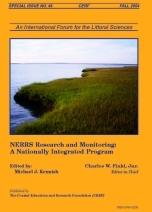Time-series observations and point measurements were used to assess seasonal patterns, tidal cycle variations, and the impact of major forcings on salinity, water temperature, turbidity, suspended sediments, and dissolved nutrients in the Webhannet River estuary (Wells National Estuarine Research Reserve). Because of the small size of the Webhannet River watershed, the main tributary of the estuary responds quickly to precipitation events, resulting in rapid increases in freshwater inputs, large decreases in salinity, and increases in suspended sediments and turbidity. Overall, suspended sediment concentrations were typically highest in the upper estuary and lowest in the Webhannet River, averaging 17.2 mg/L and 3.4 mg/L, respectively. The dissolved nutrient concentrations were variable; however, several species showed spatial and temporal patterns. Similar to suspended sediments, ammonium concentrations were typically highest in the upper estuary and lowest in the Webhannet River, averaging 4.60 μM and 1.01 μM, respectively. Average dissolved silica and nitrate plus nitrite concentrations were typically highest in the Webhannet River (32.96 and 5.13 μM, respectively) and the upper estuary (30.09 and 3.66 μM, respectively). Average orthophosphate concentrations decreased up-estuary from 0.56 μM near the mouth to 0.08 μM in the Webhannet River.
The impacts of major storms were observed during Hurricane Bob in August 1991 and Tropical Storm Floyd in September 1999. As a result of the passage of Hurricane Bob, approximately 13.49 cm of rain fell in the watershed. The instantaneous peak discharge of the Webhannet River reached 15.9 m3/s (compared with a long-term average of ∼0.5 m3/s), causing the salinity to decrease to 0.1 psu in the upper estuary and to ∼7.0 psu in the lower estuary. The suspended sediment concentrations reached 34.6 mg/L in the upper estuary. The major decrease in salinity in the lower estuary as a result of Hurricane Bob was especially noteworthy because of the significant influence of oceanic inputs. Also notable was how rapid the salinities returned to prehurricane levels at high tide (within a few tidal cycles). Conversely, minimum daily salinities, which occurred at low tide, took over 10 days to rebound to prehurricane levels. Consequently, very large fluctuations in salinity and turbidity occurred over short time scales. Other heavy precipitation events during low-discharge conditions also increased turbidity and suspended sediment concentrations by eroding the adjacent salt marshes and tidal flats.





